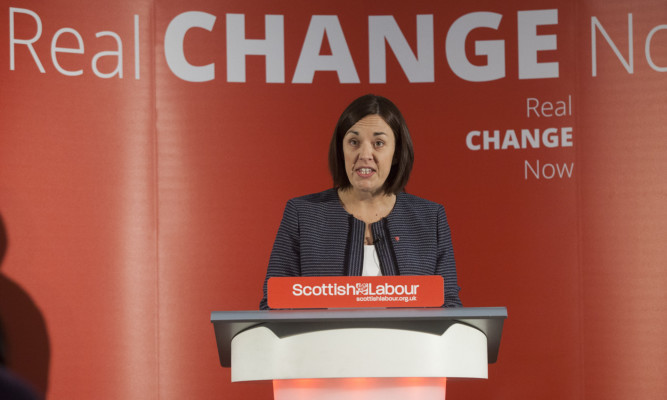Labour has challenged First Minister Nicola Sturgeon to “do the right thing for Scotland’s future” by backing its plans for a 1p rise in income tax.
Scottish Labour leader Kezia Dugdale said the tax increase, which would raise £0.5 billion, is a “radical alternative” to austerity.
The cash raised would be used to prevent cuts to education, Ms Dugdale added, as she promised rebate schemes worth £100 a year to help low-paid workers and pensioners on a low income.
Labour announced its plans the day before a Holyrood debate on the 2016-17 budget, the first one in which the Scottish Government has had a role in determining income tax rates north of the border.
With the Scottish rate of income tax due to come in on April 6, Deputy First Minister John Swinney has opted to keep payments in Scotland the same as the rest of the UK.
He is currently locked in a stand-off with councils over their funding offer in the budget, with local government body Cosla arguing authorities face a “totally unacceptable” £350 million of cuts.
In that situation, Ms Dugdale insisted these new powers “could not lie unused on the shelf”.
Making a speech in Edinburgh, she stated: “Given the choice between using our powers or making cuts to our children’s future, our nation’s future, we chose to use our powers.”
A teacher earning £29,000 a year would pay £188 more in income tax while Ms Sturgeon, who has a salary of £144,687, would have to contribute an additional £1,447, Ms Dugdale said.
She added: “Some of us will pay a little more, the wealthiest will pay the most, but we will all gain from protecting our children’s schools, the public services we love.”
Ms Dugdale conceded the move “isn’t a cold political calculation about the Labour Party’s electoral fortunes”, adding that “arguably if it was, I wouldn’t be doing it”.
She stressed more than one in four workers (810,000) “won’t lose a penny” because of a £50 million rebate scheme, which will be delivered by local councils, while about one in five (490,000) would pay less.
“One in four workers will pay no more and one in five tax payers will end up better off financially as a result of the rebate,” she vowed.
A further £25 million would be put aside for a rebate scheme for low-income pensioners who have to pay tax.
Ms Dugdale said her party’s plans are “the only credible alternative to austerity”, adding if the Scottish Government rejects them there “can be no credible claim that the SNP is an anti-cuts party”.
The Labour leader told Ms Sturgeon: “You know, First Minister, if we do not make this change it is our children, our young people and the most vulnerable in society who will pay the price. We will all be poorer.
“So, please, let’s put aside party politics, let’s come together and do the right thing for Scotland’s future.”
Labour’s announcement comes a week after the Scottish Liberal Democrats proposed a 1p income tax rise to fund investment in education.
Labour’s plans for an income tax rise received some support from unions, with Kevin Lindsay of the train drivers’ union Aslef saying: “Labour in Scotland is offering a real alternative to austerity, to the misery caused by the Conservatives and planned by the SNP, and it is an alternative which will safeguard public services throughout Scotland.”
GMB Scotland secretary Gary Smith said: “GMB Scotland welcomes the proposal to use the powers of the Scottish Parliament to raise additional revenues to mitigate the impact of the cuts in the pipeline. We have identified 8,785 job losses on the way at Scottish councils.”
Conservative finance spokesman Murdo Fraser questioned how the rebate scheme would work, saying a worker earning £20,000 a year would pay £90 more in income tax and would then have to claim the £100 rebate.
He said: “Kezia Dugdale doesn’t seem to be able to answer even basic questions about how this policy will work.
“Labour is proposing a ridiculous merry-go-round where first Labour takes money off the lowest-paid and then gets the council to hand it back.
“Can Labour tell us today how this is supposed to work? How much will it cost to administer?
“How much will basic rate taxpayers have to pay? And is Scottish Labour proposing to order councils to spend money as it sees fit?
“We need some urgent answers to this or people will simply conclude that Labour’s latest plan is a complete mess – much like the party as a whole.”
Scottish Liberal Democrat leader Willie Rennie said: “I’m pleased that the consensus is growing that action is required for our public services.
“Last week, we set out our proposals for a penny for education to deliver £475 million worth of investment for a transformational change in education. Unlike Labour, Liberal Democrats will target our investment in education.
“The financial situation in our nurseries, schools and colleges is dire, and it seems everyone apart from the SNP and Conservatives recognise that we need urgent action to save it.
“By using the powers at our fingertips as soon as they’re available in April, Liberal Democrats will take urgent action to invest in education.”
